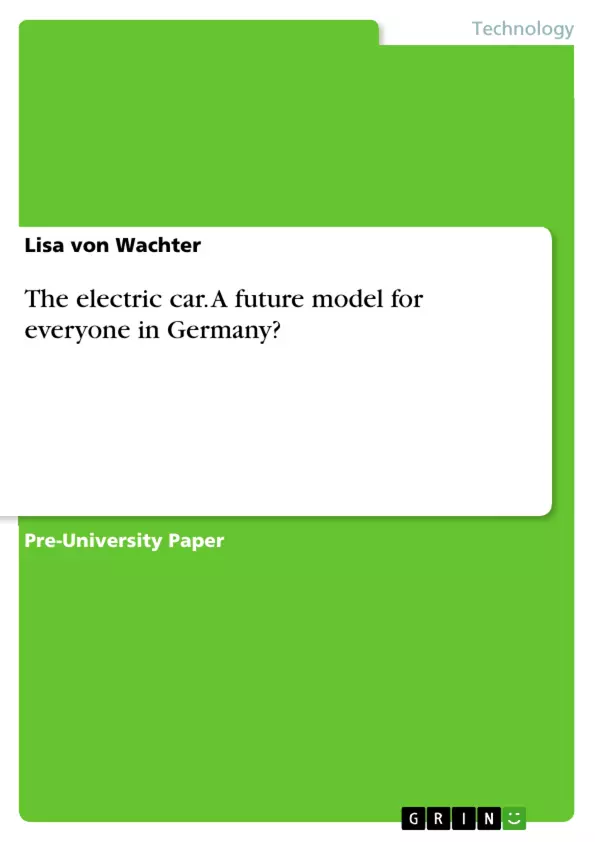One million electric vehicles by 2020 was the federal government's goal. So far, only 53,861 purely electric cars are driving in Germany (as of January 1st, 2018). However, manufacturers are having to rely more and more on electrical engineering in order not to exceed the upper limit of the permitted CO2 emissions for cars. This upper limit is further reduced by politicians in order to reduce CO2 emissions in traffic. Cars with internal combustion engines will not be able to meet these future values. The importance of electric cars in the future is therefore a topic that is being discussed more and more frequently in the media, in politics and in business. In order to advance the energy transition, Lienkamp calls for an urgent rethinking of car use. With the statement "Because I go on vacation once a year, I don't have an Airbus in the garden" he tries to convince his listeners that an electric car does not have to drive 1000 km at a time if it is primarily used for the city.
The key question in my seminar paper is whether the electric car, with its advantages and disadvantages, will be a future model for everyone in Germany. At the beginning I would like to give an overview of the topic of electric cars and describe the current situation in Germany. Among other things, I check the sustainability of the electric cars. Are they really as ecological as the proponents always say?
Then I deal with the important topic of range, which is often described as insufficient. I will also explain the situation of the charging infrastructure today and in the future. Is the charging infrastructure already sufficient, and what needs to change in the future?
The question of cost plays a relevant role and is an important decision point for many buyers. When will electric cars cost as much or even less than cars with internal combustion engines? Who will switch to an electric car and when in the future? I will deal with these questions and others in the topic of future viability of the electric car.
The content of my investigation is limited to electromobility in the passenger car sector. In addition, I will only go into the development, the sensible use of pure electric cars and their future prospects in Germany and leave out global change. Hydrogen vehicles and hybrid vehicles are not taken into account.
Inhaltsverzeichnis (Table of Contents)
- 1. Introduction
- 2. Electric cars - current status
- 3. Environmental balance of electric cars
- 4. Range of electric cars
- 5. Charging and charging infrastructure
- 5.1. Interest of politics and business
- 5.2. Impact of charging on the electricity grid.
- 6. Costs
- 7. Sustainability
- 7.1. Future development in politics, business and industry.
- 7.2. Future areas of application............
- 8. Conclusion
Zielsetzung und Themenschwerpunkte (Objectives and Key Themes)
This seminar paper aims to investigate the viability of the electric car as a future model for everyone in Germany. It explores the current status of electric cars in Germany, their environmental impact, range limitations, charging infrastructure, costs, and sustainability.
- The current state of electric car adoption in Germany
- The environmental benefits and drawbacks of electric vehicles
- The range of electric cars and the limitations of charging infrastructure
- The cost of electric cars compared to traditional vehicles
- The future viability of electric cars in Germany
Zusammenfassung der Kapitel (Chapter Summaries)
The introduction lays out the research question and provides context regarding the importance of electric vehicles in the context of Germany's energy transition and CO2 reduction goals. It also clarifies the scope of the study, focusing on passenger car electromobility in Germany.
Chapter 2 explores the history of electric cars and their current status in the German market. It provides data on the number of electric cars sold in Germany and outlines the basic principle of electric car operation.
Chapter 3 examines the environmental impact of electric cars, discussing their potential benefits and drawbacks in terms of CO2 emissions and other environmental considerations.
Chapter 4 discusses the range limitations of electric cars and the factors that influence their range, such as battery capacity and driving conditions. This chapter also delves into the current state of charging infrastructure in Germany.
Chapter 5 investigates the charging infrastructure in detail, covering the interests of politics and business in its development, and the potential impact of widespread electric car adoption on the electricity grid.
Chapter 6 analyzes the costs associated with electric cars, including the purchase price, charging costs, and maintenance costs, and discusses the potential for cost parity with traditional vehicles.
Chapter 7 delves into the sustainability of electric cars, exploring their long-term viability, future development, and potential areas of application. It discusses the role of politics, business, and industry in shaping the future of electric vehicles.
Schlüsselwörter (Keywords)
The main keywords of this seminar paper include electromobility, electric cars, sustainability, range, charging infrastructure, cost, and future viability. These keywords are central to the research question of whether electric cars can become a mainstream transportation option in Germany.
- Quote paper
- Lisa von Wachter (Author), 2018, The electric car. A future model for everyone in Germany?, Munich, GRIN Verlag, https://www.grin.com/document/1185800



